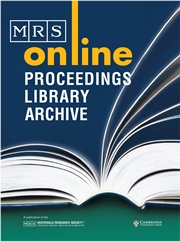No CrossRef data available.
Article contents
Application of Bogoliubov-de Gennes equations to vortices in Hubbard superconductors
Published online by Cambridge University Press: 16 February 2015
Abstract
In this work, the formation of d-wave superconducting magnetic vortex is studied within the Bogoliubov-de Gennes formalism and the generalized Hubbard model, which leads to 2N2 coupled self-consistent equations for a supercell of N×N atoms. These equations determine the spatial variation of the superconducting gap as a function of the electron concentration and electron-electron interactions. The results show that the superconducting states induced by the correlated hopping (Δt3) are more sensitive to the presence of magnetic field than those induced by attractive nearest-neighbor interaction (V). Furthermore, we calculate the electronic specific heat as a function of the temperature for a given applied magnetic field, whose behavior has a qualitative agreement with experimental data.
- Type
- Articles
- Information
- MRS Online Proceedings Library (OPL) , Volume 1753: Symposium NN – Mathematical and Computational Aspects of Materials Science , 2015 , mrsf14-1753-nn03-03
- Copyright
- Copyright © Materials Research Society 2015




